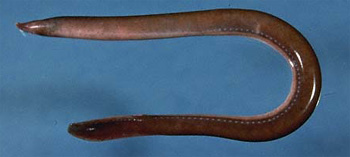Introduction
Myxine, commonly known as hagfish, is a jawless marine organism belonging to the class Myxini and order Myxiniformes. It is one of the most primitive vertebrates, often referred to as a “living fossil,” as it retains many ancestral traits. With its elongated, eel-like body, Myxine lacks jaws, paired fins, and scales, making it distinct from more advanced fish.
Hagfish are best known for their ability to produce copious amounts of slime as a defense mechanism. They primarily scavenge on dead or dying marine animals, playing a crucial role in the decomposition process and nutrient cycling within their ecosystems. Despite their simple body structure, they exhibit remarkable adaptability and resilience, thriving in deep-sea environments.
Classification of Myxine – Hag Fish
- Phylum :- Chordata (Dorsal tubular nerve cord, notochord and gill-slits present.)
- Group :- Acraniata (No head, cranium or brain)
- Sub phylum :- Vertebrata (Vertebral column present.)
- Division :- Agnatha (Jaws and paired appendages absen)
- Class :- Cyclostomata (Mouth circular, suctorial, without jaws)
- Order :- Myxiniformes (Mouth without funnel, with 8 tentacles. Gills 10 to 14 pairs. Branchial basket feebly developed.)
- Family :- Myxinidae
- Genus :- Myxine

Geographical distribution
- Myxine is distributed along seacoasts of the Atlantic and Pacific oceans in North European, North Atlantic, American and Japanese sea waters.
- Found in oceans worldwide, primarily in temperate and cold waters.
- Inhabit deep-sea environments, typically at depths ranging from 20 to 1,200 meters.
Habit and habitat
- Hagfishes or Myxine sometimes descend to a depth of 300 fathoms. They are purely marine, nocturnal and lie buried in the muddy bottom. They are parasitic or quasiparasitic and generally found attached to the body of fishes, especially around gill area. They bore their way into host body to eat viscera and muscles.
- Habit:
- Scavengers, feeding on dead or decaying fish and other marine animals.
- Can burrow into the seafloor or into carcasses for feeding.
- Habitat:
- Resides in deep-sea environments, often in muddy or sandy substrates.
- Thrives in cold, oxygen-depleted waters, making them well-suited to extreme environments
Comments on Myxine – Hag Fish
- Commonly called as hagfish or borer.
- Body is soft, without scales, worm-like, measuring about 60 cm in length and differentiated into head, trunk and tail.
- Anterior extremity contains four tentacles supported by skeletal rods.
- Mouth is terminal and surrounded by lips. Buccal funnel, and jaws are absent.
- There is a single nostril present close to the mouth. On ventrolateral sides mucous pores and distinct.
- Dorsal fin indistinct caudal tin and ventral fin confluents.
- Eyes vestigial, due to dark and bottom dwelling habit, photoreceptor organ is reduced.
- Secrete enormous mucus through mucous pores.
- 10 to 14 pairs of gills open into a branchial chamber, which opens to the exterior by a single branchial opening.
- Hermaphroditic and protandrous. Eggs are enclosed in horny shell, bearing hooks by which they attach themselves to the weeds.
Ecological Importance
- Economic importance : Hagfishes damage fish caught in nets. Sometimes hagfishes enter into the body of other fishes and eat entire soft parts leaving only a bag of skin and the bones.
- Nutrient Recycling: Contributes to the breakdown and recycling of organic matter in marine ecosystems.
- Food Web Role: Acts as prey for larger predators, such as sharks.
- Ecosystem Balance: Helps maintain the health of deep-sea ecosystems by scavenging and consuming decomposing organic matter.
Conservation Status
- Not currently listed as endangered, but some species face threats from overfishing and habitat degradation.
- Harvested in some regions for their skin (used as “eel leather”) and as food.
- Deep-sea trawling and bycatch pose risks to populations.

Special features
- In hagfishes same individual produces sperms and then eggs later on. Development is direct. The hagfishes are injurious to fish industry. They are important from evolutionary point of view. The evolution of jawed vertebrates from agnathans could be hypothesized as the latter needed only jaws.
- Although no direct link is available to understand evolution of gnathostomes, but some armoured agnathan might have served as ancestor to the jawed vertebrates.
Identification
- Since the animal has 4 tentacles, single gill aperture and no buccal funnel and above features, hence it is Myxine.
References
- National Oceanic and Atmospheric Administration (NOAA) – Sea Lamprey
- Encyclopedia of Life – Petromyzon marinus
- Great Lakes Fishery Commission – Sea Lamprey Control
- Marine Species Identification Portal – Petromyzon
- World Register of Marine Species (WoRMS)
- Zoology Practical Vertebrate


Pingback: BDELLOSTOMA | Zoologyverse | 2025
Pingback: LOWER JAWS OR MANDIBLES IN VERTEBRATE | Zoologyverse | 2025
Pingback: Vertebrates : Definition, Classification and Characteristics | Zoologyverse | 2025
Pingback: Pisces : Definition, Classification and Characteristics | Zoologyverse | 2025